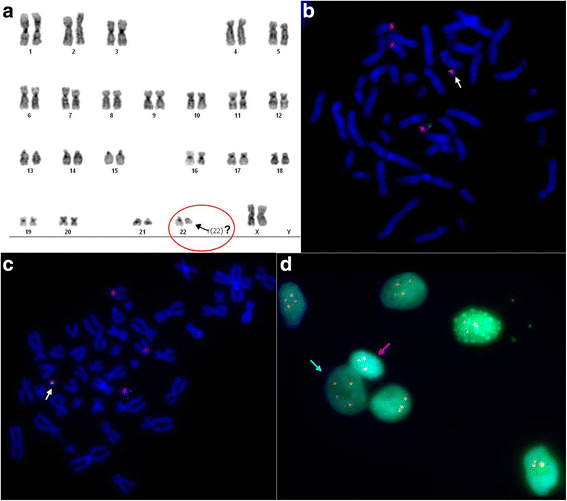Compound phenotype in a girl with r(22), concomitant microdeletion 22q13.32-q13.33 and mosaic monosomy 22
- PMID: 29736186
- PMCID: PMC5923029
- DOI: 10.1186/s13039-018-0375-3
Compound phenotype in a girl with r(22), concomitant microdeletion 22q13.32-q13.33 and mosaic monosomy 22
Abstract
Background: Ring chromosome instability may influence a patient's phenotype and challenge its interpretation.
Results: Here, we report a 4-year-old girl with a compound phenotype. Cytogenetic analysis revealed her karyotype to be 46,XX,r(22). aCGH identified a 180 kb 22q13.32 duplication, a de novo 2.024 Mb subtelomeric 22q13.32-q13.33 deletion, which is associated with Phelan-McDermid syndrome, and a maternal single gene 382-kb TUSC7 deletion of uncertain clinical significance located in the region of the 3q13.31 deletion syndrome. All chromosomal aberrations were confirmed by real-time PCR in lymphocytes and detected in skin fibroblasts. The deletions were also found in the buccal epithelium. According to FISH analysis, 8% and 24% of the patient's lymphocytes and skin fibroblasts, respectively, had monosomy 22.
Conclusions: We believe that a combination of 22q13.32-q13.33 deletion and monosomy 22 in a portion of cells can better define the clinical phenotype of the patient. Importantly, the in vivo presence of monosomic cells indicates ring chromosome instability, which may favor karyotype correction that is significant for the development of chromosomal therapy protocols.
Keywords: Chromosome 22 monosomy; Compound phenotype; FAM19A5 gene; Phelan-McDermid syndrome; Ring chromosome 22.
Conflict of interest statement
The study was approved by the local Research Ethics Committee of the Research Institute of Medical Genetics, Tomsk NRMC. Written informed consent was obtained from the parents of the patient for her participation.Written informed consent was obtained from the parents of the patient for the publication of the clinical data and pictures.The authors declare that they have no competing interests.Springer Nature remains neutral with regard to jurisdictional claims in published maps and institutional affiliations.
Figures



References
-
- De Mas P, Chassaing N, Chaix Y, Vincent MC, Julia S, Bourrouillou G, et al. Molecular characterisation of a ring chromosome 22 in a patient with severe language delay: a contribution to the refinement of the subtelomeric 22q deletion syndrome. J Med Genet. 2002;39:e17. doi: 10.1136/jmg.39.4.e17. - DOI - PMC - PubMed
-
- Guilherme RS, Soares KC, Simioni M, Vieira TP, Gil-da-Silva-Lopes VL, Kim C, et al. Clinical, cytogenetic, and molecular characterization of six patients with ring chromosomes 22, including one with concomitant 22q11.2 deletion. Am J Med Genet A. 2014;164A:1659–1665. doi: 10.1002/ajmg.a.36512. - DOI - PubMed
Grants and funding
LinkOut - more resources
Full Text Sources
Other Literature Sources
Research Materials
Miscellaneous

